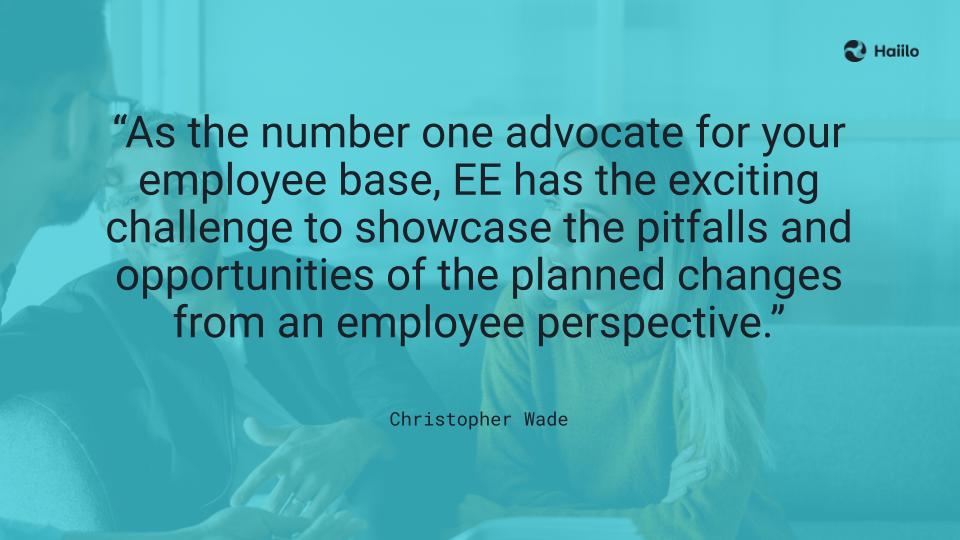TYING employee engagement (EE) to your company’s business performance starts with building your personal profile and credibility as an EE leader, a key enabler to ensure you have a voice at the table of your executive leadership, writes Christopher Wade.
This is not a new topic, but one I want to share my particular spin on: How to ensure your C-suite brings employee engagement (EE) to the table for key strategic decisions impacting employees in your organization.
I’ve seen similar questions raised and answered in many forums and publications over the years, especially as the importance and relevance of EE has increased. There is no silver bullet to this ongoing challenge, but I do want to share my own personal experience operating at C-suite level for many years at several Fortune 500 companies, including as a board member myself. The key ingredient: Tie EE to company performance.


Our raison d’être
With most organizations in some form of transformation – whether automation, digital transformation, M&A, (ongoing) restructuring or whatever it may be – it is our job to advise and support our executive leadership in getting the employee base to (1) understand the changes happening, (2) how it will benefit them and the company and (3) how they can support the change no matter their individual role. In an ideal situation, your executive leadership is including you in the process as the transformation program is being developed, allowing you and your team to help shape the messages, communications approach and delivery mechanisms, as well as how to measure the success of the communication(s) and change. Worst-case, you will be tasked with developing the above after the fact. This can be challenging, often like trying to fit a round peg into a square hole. In either case, regardless of your level of involvement in the development process, this is your opportunity to shine.
As the number one advocate for your employee base, EE has the exciting challenge to showcase the pitfalls and opportunities of the planned changes from an employee perspective. The main task is to effectively share the transformation story to garner positive sentiment across the organization to support the change. However, this article isn’t about the strategic and tactical aspects of an effective communications plan; rather, it’s about how to elevate the position of EE with your executive leadership when they are making big decisions regarding transformation/change – so let’s dive in.

The foundation: Build relationships with your C-suite
It seems pretty basic, but whether just starting out or if there is an ongoing transformation happening at your company, set up meetings with your key stakeholders – yes, I do mean your C-suite (and/or one level below). You can’t be recognized as a strategic advisor if you aren’t interacting with them, including on a one-on-one basis. Have something to share (your latest data analytics, for example) and how this positively or negatively impacts the stakeholder(s). This will enable you to engage in a meaningful dialogue to adjust any ongoing engagement strategy or tactics for that stakeholder. As important as this is, the more significant outcome of any meeting will be to ensure you understand the three biggest challenges the stakeholder(s) is facing. Just by asking the question ‘What are your biggest three challenges?’, you will learn the topics that most interest your counterpart(s) – and perhaps you even have an idea that might help them overcome the challenge(s) (regardless if it’s an employee engagement solution). The biggest win from these interactions will be to establish or enhance your business understanding. It will also facilitate your future interactions and discussions, and provide you with additional context on how to develop your EE plans and tactics to support the right business priorities.
The benefits are that you establish yourself as a strategic partner, increasing the likelihood you will be included in future strategic discussions, and you gain insights into the business challenges facing your C-suite, which can lead to better EE strategy and tactics as well as demonstrate and/or increase your business acumen.

Raise expectations (using data)
Actions speak louder than words or better yet, results speak louder than words. Your C-suite uses data every day to make informed decisions. To speak the same language when talking about EE and raise the expectations of how this discipline can positively impact your organization, we need to do the same. For me, that translates to the following: Using data to measure how we are performing, making ourselves accountable to our leadership. Just like colleagues in sales or HR, having metrics to present and initiate a discussion on what is working (and what is not) is a sure case way to get invited to more discussions in future. The next question of course is ‘What do you measure?’ There are many metrics I could list, but ultimately, try to tie your EE metrics to company performance. Look for metrics that can bring this correlation to life. The data may not always be a direct line, depending on what you or your company is tracking and measuring, but find a corollary. The C-suite should see that if we drive employee engagement up, we see an improvement in the company’s performance. There is no more powerful data point or correlation to raise the standing of EE with your C-suite.
I’ve had conversations with practitioners in the past where there was disagreement on whether EE should measure itself to company performance. Some might find this contradictory to the purpose of what we should be doing. I disagree. Naturally, our aim is to engage our employee base, to build pride, to give our colleagues purpose in the work they do every day, so they can be better organizational advocates to keep and grow our customer base and attract the best talent… all of these things are part of EE. But these goals also have the opportunity to tie into a higher ambition and correlation with company performance. Bottom line (pun intended) is every employee at a company is paid to help the company succeed, so EE should demonstrate the ultimate impact of our work accordingly. We need to measure and showcase how we inform, engage and inspire employees to do their jobs better, which should lead to improve company results – whether through higher EE scores, accelerated transformation metrics, increased cost reductions or higher profitability. Being bottom-line focused is not contradictory to being an employee advocate; both can be true at the same time and are an enabler to raise the profile and importance of the passionate work we do every day.
The benefits are that this generates genuine, ongoing interest from your C-suite in EE by providing data for them to measure your performance, leading to a richer dialogue and ongoing interest in our discipline as we also demonstrate our accountability (ultimately leading to raised expectations of what EE can deliver for an organization).


We are storytellers, leverage that
Based on the above, I’ve provided recommendations on why as EE practitioners we should use data to both track how our plans and activities are performing – to learn from and continuously improve – but also to talk the language of our executive leadership. Making ourselves accountable in the field of EE, with far less metrics to showcase versus the sales and HR counterparts I mentioned earlier, is an enabler to create a revolving door to engage with our C-suite. Where we can shine versus other functions is how we shape the narrative around the data points we track. We’re natural storytellers and whether we have fantastic stats (showcasing our measures are working) or we see that we are not achieving our targets, both give us the opportunity to enter into a dialogue with our C-suite on what we need to do more or less of. There is certainly risk in exposing ourselves, but just like any P&L leader in your organization, this is the best way to showcase the value you and your team bring and so create the opportunity to add your voice to the table when big decisions are being made at your company.
The benefits are that you leverage your natural affinity for storytelling to shape the narrative of what needs to happen in the EE space to help the organization improve its performance (leverage data as a source for narrative creation).

Intangibles
All of this is easier said than done, but I’ve been fortunate enough to live the above at multiple companies and layers of an organization. Needless to say, there are intangibles that are of the utmost importance to raising your EE leadership, such as having a professional appearance and demeanor: Your C-suite needs to ‘see’ you as a strategic advisor; having real business acumen and being able to lead a dynamic conversation with your C-suite about their challenges and how EE can play an essential role to support overcoming them, and having rich experience to back up your opinions and recommendations.
All of the above are necessary prerequisites in one form or another. In addition to the many who are already working at this level, I’ve met many EE leaders who have the talent and expertise to do so as well, but not always been afforded the opportunity. I hope some of the ideas mentioned above support you in creating those opportunities and raising your EE leadership to have a voice at the table at your organization.
Finally, we may not always get the support – budget, messaging alignment, C-suite participation and willingness to experiment – that we need. However, if we are measuring our impact, we can use results hitting below expectations to challenge leadership to do things differently or to invest more to achieve the desired outcomes.

This article originally appeared on Strategic and is reprinted with the permission of the author.
About the author
Christopher Wade is a strategic communications professional who drives innovative, data-driven stakeholder engagement. Through a people-focused employee engagement approach, he helps businesses drive improved performance. He has over 15 years of leadership experience, developing international teams to higher achievement. Wade translates company strategy into easy-to-understand messages, visual stories and engagement activities that build trust and positive company culture. He listens, leads by example, mentors and delivers on comprehensive plans and detail-oriented materials alike – on time and in crisis.









